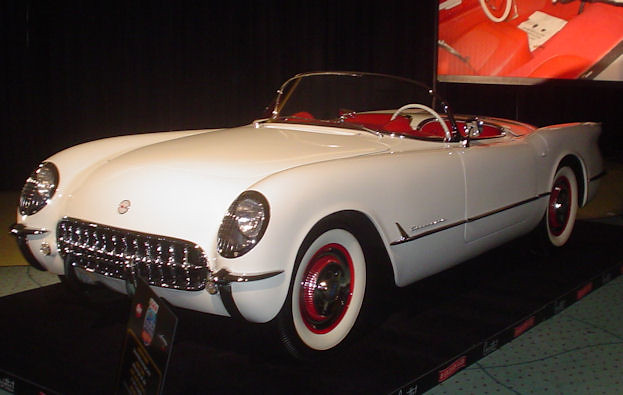
|
| Photo Credit: Chris Nagy |
The 2023 Chevrolet Corvette is one of the finest-tuned and most recognized performance machines made. Featuring a meticulously sculpted shape combining elements of race cars and jet aircraft, the Corvette’s recent evolution to a rear mid-engined layout for its eighth generation has been a lengthy pursuit for perfection. The 2020 Corvette Stingray with its 495-horsepower Small Block V8 engine contributed to the fastest stock acceleration from 0 to 60 miles per hour while the Z06 edition of the sports car rose the vehicle to the peak of automotive athleticism with a 670-horsepower LT6 powerplant. The book of 70 years of history has been written by eight major revisions that progressed from a modest performer. On this day (June 30th), the first chapter for the Chevrolet Corvette’s story began to be written inside a Flint, Michigan factory where the first car was assembled with less precision and polish than the modern icon.
Starting life as Project Opel, development for basis of the Chevrolet Corvette started under the guidance of General Motors’ top stylist Harley Earl, Chevrolet’s general manager Thomas Keating and engineer Ed Cole. Also steering the project for the sports car was Maurice Oiley who arrived at General Motors from Britain with expertise that included a tenure with Rolls Royce. Based on a full-sized Chevrolet car chassis, a two-passenger, two-door convertible concept featured a beautiful silhouette formed using then-revolutionary composite material recognized as fiberglass. With a fiberglass (also technically known as glass reinforced polymer), it seemed possible to create a strong yet lightweight body.
The finished prototype called EX-122 was first shown to the public at New York City at General Motors’ 1953 Motorama in January of that year. As the shape of the new car dazzled the American crowd, production of the Corvette was given the greenlight. Despite being a radical design departing from what Chevrolet had been developing at the time, slightly more than six months was assigned to make customer-ready examples of the convertible.
Although preparations of the Corvette immediately saw use of Chevrolet’s existing parts bin for many components including its powerplant, there were a number of challenges in creating the identity for the production model. Even as the EX-122 show car was envisioned, the hood badge was initially planned to feature the United States flag. However, due to concerns with the legal usage of the American symbol a design featuring a checkered flag beside a red flag using a fleur-de-lis and Chevrolet’s bowtie was opted for the prototype.
However, the most troublesome production complication for the 1953 Chevrolet Corvette was its fiberglass body. The relatively new material being used so extensively in the exterior shape of the new car was understood from the start to be a key component to the Corvette’s design but its initial promise also presented headaches for assembling a vehicle. Early delivery of fiberglass panels arrived from their manufacturer with air bubbles that ruptured during the painting procedure. Additionally, the hand-built assembly of the first Corvettes resulted in varying degrees of fit and finish. Two factors that supported the auto company’s election to use fiberglass for the Corvette were the vehicle’s low initial production targets as well as the manufacture tooling able to be done quickly and more cost effectively than for forming steel panels. Besides the inconsistencies of the body assembly, some 1953 Chevrolet Corvettes left the factory with the wrong wheel covers. Instead of the intended wheels featuring a mock knock-off hub, part shortages caused some cars to be equipped with covers from the Chevrolet Bel Air.
Once one of the Corvettes would be assembled, turning the keys over to customers was regulated closely by Chevrolet. Attention was devoted to establishing a halo over the new car. After all, the original base retail price of $3,498 for the 1953 Chevrolet Corvette was almost $300 above the median income for the United States at the time. Of the 1953 run of Corvettes, only 183 vehicles were actually sold. Hollywood performer and Chevrolet pitch person Dinah Shore as well as screen legend John Wayne were some of the first owners of the car. The problem was that while the Corvette sported a premium price, amenities included in the vehicle was rather basic. Side windows were rolled up curtains while an AM radio and heater cost extra.
Finally, a stumbling point for the first year of the Chevrolet Corvette was the uninspiring power. The 235 cubic-inch inline-six powerplant (marketed as the ‘Blue Flame’ engine for its block colouring) was a modified version of an existing Chevrolet engine given upgrades including three side-draft carburetors and increased compression for 150 horsepower. This powerplant was mated to a Powerglide automatic transmission resulting in an underwhelming performance driving experience when combined with an unremarkable suspension and weak brakes.
Chevrolet’s original direction for an American sports car missed its mark with customers in 1953 but the essence of what could be a successful performance machine was realized. From the first Corvette, names such as Zora Arkus-Duntov, Bill Mitchell, Larry Shinoda, Dave McLellan, David C. Hill and Tom Peters are among a few notable contributors that have guided the car into the showstopping vehicle it is today.
References:
Census.gov
Chevrolet.com
Bingham, Phillip (1990). Supercars: Chevrolet Corvette, 4-9
Burton, Jerry (). Corvette: America’s Sports Car Yesterday-Today-Tomorrow, 27-39

Comments
Post a Comment